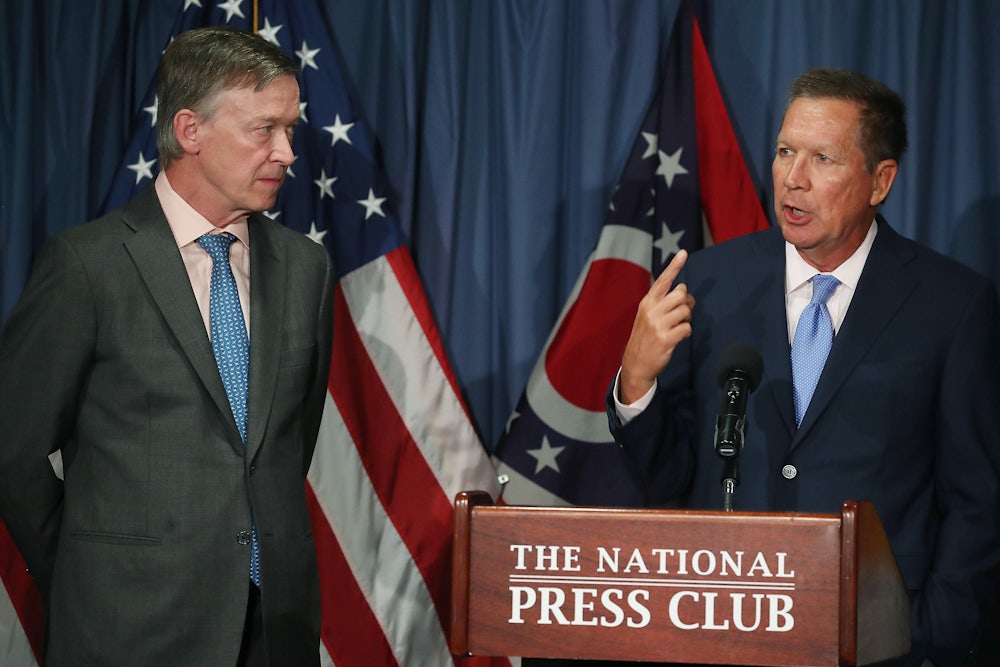One of the most persistent fantasies in American politics is that there is a plurality of dissatisfied voters just waiting for a centrist, post-partisan, “common sense” savior. Donald Trump’s successful presidential campaign should have buried this fantasy once and for all. Trump won by taking the opposite tack: He played to America’s basest instincts; he was more combative and partisan than any candidate in recent history; and he was totally full of it, selling pipe dreams that spat in the face of common sense. It worked.
And yet the fantasy of a technocratic centrist savior, instead of being consigned to a shallow grave, is flourishing. Figures like Facebook’s Mark Zuckerberg and Starbucks’s Howard Schultz have tentatively stepped forward as political Goldilockses, offering a mix of pro-business and socially liberal values in an environment where the Democratic Party is racing leftward on economic issues and the Republican Party is rebranding from slyly racist to overtly racist. But the centrist dream is perhaps best expressed by Ohio Governor John Kasich, who has emerged as one of Trump’s most prominent critics.
Kasich is clearly planning on a run of some kind. The question is whether he’ll mount a primary challenge against Trump or an independent bid. And given the fact that Republican voters roundly rejected Kasich in the last primary—he finished fourth, winning only one state—the latter seems more viable. Last week, Axios reported that Kasich is mulling a third-party “No Labels”-style run in 2020, with Democratic Governor John Hickenlooper of Colorado as his running mate. But despite Kasich and Hickenlooper’s shared commitment to common-sense politics, their ticket would appeal to a certain subset of the donor class and almost no one else.
Since Trump’s election, and particularly since the Republican Party’s failed attempt to repeal Obamacare, Kasich has hammered the president for his lack of decency and his divisiveness and his party for its draconian plan to uninsure millions of Americans. He has leaned heavily into his “Prince of Light and Hope” schtick, except now he barely has to work to make the case that he’s a sane, sensible Republican alternative.
He has traveled abroad, to the very presidential countries of Germany, Great Britain, and Japan. He wrote a book, Two Paths: America Divided or United, to lay out his vision in greater detail. And on Thursday, Kasich and Hickenlooper released a bipartisan plan, endorsed by a handful of other governors, to stabilize Obamacare.
The Kasich-Hickenlooper plan is pretty standard stuff. It would keep the individual mandate—hated by conservatives—in place, guarantee that the federal government would pay insurers, and ensure that the federal government was still doing all it could to encourage enrollment. It doesn’t give conservatives much on their health care wish list, though it does increase autonomy in setting basic coverage requirements and make it slightly easier to get waivers for regulations. It doesn’t go as far as Democrats want, with the party quickly coalescing around some version of Medicare for All as an end goal.
It’s basically the kind of plan that you’d expect from Kasich: modest, common-sense, and therefore bipartisan, albeit in a meaningless way. Other than coming down on the side of keeping the individual mandate, it steers clear of the minefields that have cropped around Obamacare for the last seven years in favor of minor fixes.
The problem is that politics is minefields. And, as the success of Donald Trump (and on the left, Bernie Sanders) has shown, huge swaths of both parties want sharp-elbowed candidates who wade into these minefields, whether they be immigration or health care. These are issues about which little consensus exists between the two parties.
People may be tired of partisanship and legislative bickering, which helps explain Congress’s 16 percent approval rating. But that doesn’t mean that what they’re clamoring for is consensus—in most cases, they’re clamoring for more fighting. Trump’s horrifying repeal of DACA—the policy that has protected hundreds of thousands of so-called Dreamers from deportation—is a ploy to the base that propelled him to the presidency. On the other side, though more commendable, you have Medicare for All emerging as a litmus test.
There are undoubtedly voters stuck between these camps, but there are fewer of them, proportionally speaking, than you would expect from reading the news. People may complain about partisan fighting, but they keep backing candidates who fight. The persistence of the centrist fantasy mostly shows that the voices who clamor for such a ticket are overrepresented in media and politics.
Boring bipartisan policy compromises could actually lead to good, desirable results. But it would be actively harmful if Kasich and Hickenlooper launched a split ticket. It would all but guarantee that Trump would win a second term, so long as he was able to hold on to about 40 percent of the vote. If the Democrats were to nominate a leftist in the mold of Bernie Sanders, Kasich and Hickenlooper would create a party for affluent people disaffected by Trump’s demagoguery but scared of Sanders’s socialism. It would be little more than a consultant’s fantasy, one that would get, maybe, 15 percent of the vote.
If Kasich does want to make himself useful, he should primary Trump. It’s unlikely that things would play out any differently in 2020 than they did in 2016. But a primary campaign would damage Trump, maybe fatally. That wouldn’t fulfill anyone’s fantasies about bipartisanship, but it would be useful.
